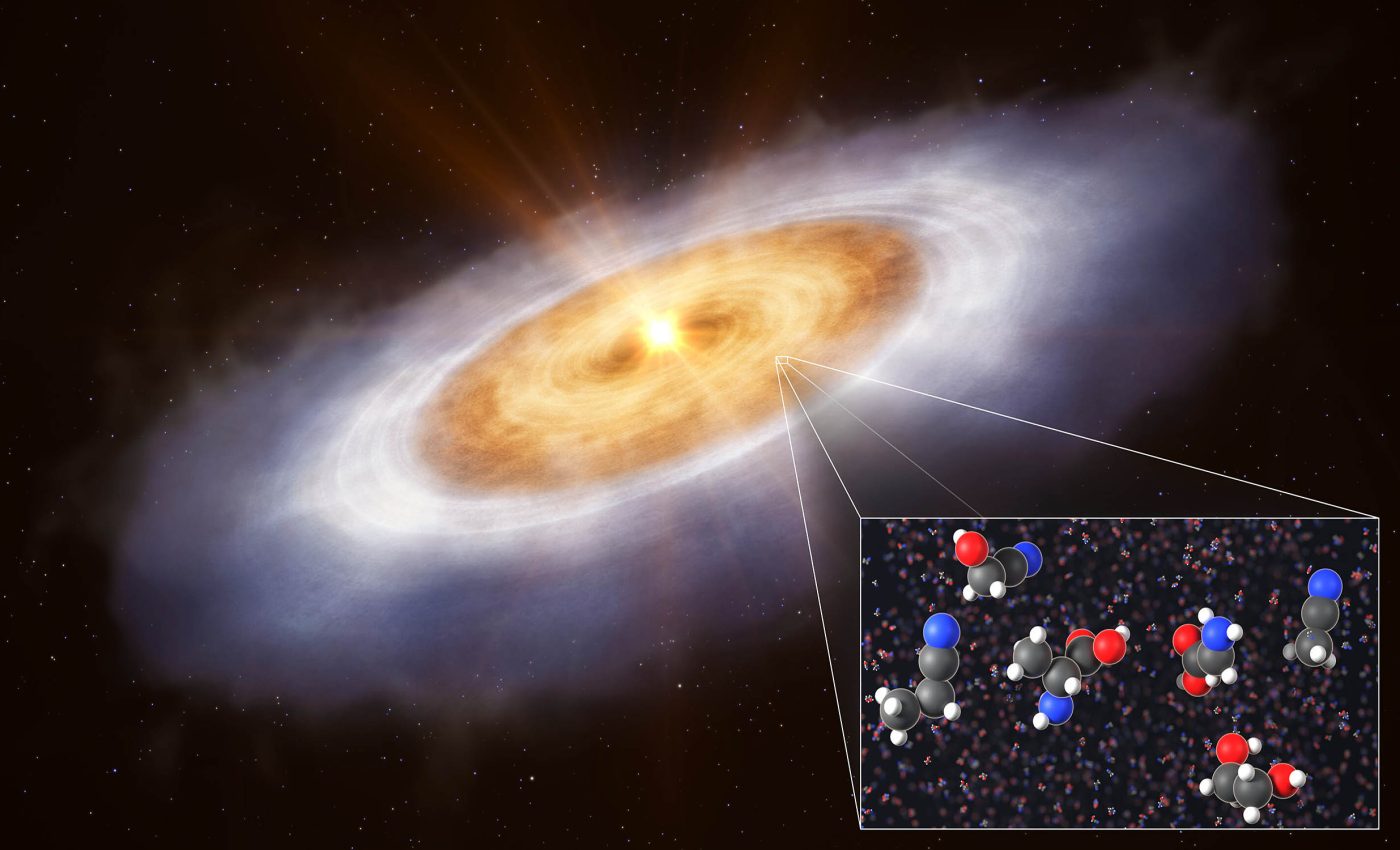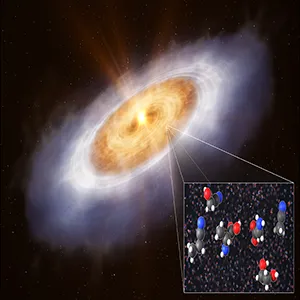
Complex molecules found orbiting a young star strongly point to the origins of life
Earlier this month, astronomers studying the young star V883 Orionis reported spotting complex organic molecules floating in its dusty disk that’s in the process of forming planets.
The discovery hints that life’s chemical toolbox gets stocked well before rocky worlds are even stirred together.
Among the 17 molecular species identified were ethylene glycol and glycolonitrile, both considered stepping stones toward sugars and amino acids.
The project was led by Abubakar Fadul at the Max Planck Institute for Astronomy (MPIA).
Young star named V883 Orionis
V883 Orionis, which is 1,300 light-years away in Orion, is flaring as it gorges on infalling gas, briefly raising parts of its protoplanetary disk above the water-ice line.
That extra warmth liberates chemicals that were frozen onto dust grains, which sends tell-tale radio signals toward Earth.
Using the Atacama Large Millimeter/submillimeter Array in Chile (ALMA), Fadul’s team mapped radiation frequencies between 348 and 366 GHz, isolating 15 emission lines from ethylene glycol and six from glycolonitrile.
The hotter molecule traces gas around 570°F (300°C), while its cooler cousin prefers about 190°F (88°C).
“Our finding points to a straight line of chemical enrichment and increasing complexity between interstellar clouds and fully evolved planetary systems,” said Fadul.
Life molecules freed from ice
Comet observations show that ethylene glycol easily slips from ice when sunlight or mild heat lofts it into space. V883 Orionis supplies the same gentle oven, but on a grander, disk-wide scale.
Glycolonitrile has been detected in dense clouds near the galactic center, proving it can form and survive in harsh stellar nurseries. Its presence in V883 Orionis suggests that survival continues right into the planet-building zone.
In space, ethylene glycol can oxidize into glycolaldehyde, a simple, two-carbon sugar. That sugar was spotted around a young solar-type protostar in Ophiuchus nine years ago.
Laboratory experiments show that glycolonitrile reacts with ammonia to yield glycine, the simplest amino acid, and joins with other nitriles to make adenine, one of DNA’s four bases.
Finding both precursors in the same disk raises the possibility that sugars, acids, and nascent genetic material can migrate together onto pebbles that will seed future planets.
Life’s chemistry in V883 Orionis’ dust
Many researchers believed outbursts and radiation destroyed inherited molecules, requiring disks to completely rebuild their chemistry from scratch. The new observation tilts the debate back toward inheritance.
Spectral surveys of massive, star-forming cores already list more than two hundred organic species, including ethylene glycol and relatives.
Chemical models show methanol, once locked in ice, endures for millions of years in disk midplanes, later feeding bigger molecules such as ethylene glycol.

Because the outburst heats a wide area of the disk, astronomers can track the chemistry across different regions.
These regions will eventually become asteroid belts, icy rings, and zones where giant planets form – offering a preview of the chemical layout in developing planetary systems.
Ancient ice holds life clues
Rosetta’s ROSINA instrument sniffed glycine venting from comet 67P/Churyumov-Gerasimenko in 2016. That find proved that amino acid building blocks can hitch rides on icy bodies that eventually rain down on young planets.
Ethylene glycol has turned up in the tails of comets like Lemmon and Lovejoy, underscoring the match between solar system leftovers and V883 Orionis chemistry.
Comets act as time capsules, preserving the Sun’s protoplanetary ice for 4.5 billion years.
Each molecular match between those relics and faraway disks strengthens the argument that the delivery of life-building organics to young planets is a standard step, not a quirk of our history
Gaps the models must close
Current disk simulations underproduce glycolonitrile, indicating that additional surface pathways, such as UV-driven reactions between formaldehyde, ammonia, and hydrogen cyanide, are still missing.
Adding these energetic routes may also explain why the molecule pops into the gas so readily during stellar flares.
Laboratory studies on cold-grain chemistry continue to improve our understanding of reaction networks.
However, these networks often leave out the latest radiation experiments, forcing scientists to estimate reaction rates that are still poorly measured.
Questions still remain
The ALMA spectra show almost no sign of glycolaldehyde, even though the molecule readily converts to ethylene glycol in laboratory ice studies.
Researchers wonder whether rapid hydrogenation or destruction by hydroxyl radicals keeps the sugar’s signature too faint to see.
Better spectral resolution and follow-up at other wavelengths will help disentangle blended lines and perhaps reveal even heftier organics, from simple peptides to phospholipid precursors.
Scientists still don’t know whether the chemical levels change across the disk or follow patterns called snow lines for each molecule. Answering that question would take sharper images than ALMA can currently provide.
Next steps for V883 Orionis
The team plans to revisit V883 Orionis once the outburst subsides, so that they can compare hot and cold chemistry in the same system. Such time-lapse snapshots could show which molecules linger and which vanish as the disk cools.
Meanwhile, other groups are targeting similar flare-up stars of different ages, aiming to chart a timeline of organic complexity across the journey from interstellar cloud to comet.
Future disk surveys with the upcoming ngVLA will be ten times more sensitive. This could help detect sugars, peptides, and key cell-forming molecules in many star-forming regions.
Planets may start life-ready
If most disks start with a rich stockpile of prebiotic molecules, nascent planets everywhere may inherit a chemical head start on life.
Meteorites that fall to Earth have been found to contain the building blocks of genetic material, like cytosine and uracil.
Scientists already simulate how comet impacts on young planets like Earth could have delivered the building blocks of life.
Now, they’re extending those simulations to distant star systems like V883 Orionis to see if young planets there could receive similar amounts.
The new ALMA data suggest that delivery service begins well before meteorites form, boosting the odds that rocky worlds across the galaxy begin their stories with similar ingredients.
The study is published in The Astrophysical Journal Letters.
—–
Like what you read? Subscribe to our newsletter for engaging articles, exclusive content, and the latest updates.
Check us out on EarthSnap, a free app brought to you by Eric Ralls and Earth.com.
—–













